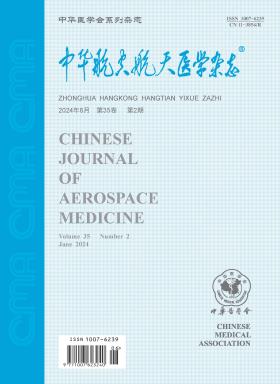飞行员阻塞性睡眠呼吸暂停低通气综合征流行病学调查
引用次数: 0
摘要
目的了解飞行员阻塞性睡眠呼吸暂停低通气综合征(OSAHS)的患病率,为飞行员OSAHS的防治提供参考。方法随机抽取236名飞行员填写Epworth嗜睡量表(ESS)评分问卷。收集了他们的年龄、吸烟和饮酒习惯。他们的颈围、身高、体重和身体质量指数(BMI)也被测量。通过夜间血氧饱和度、呼吸暂停低通气指数(AHI)等指标监测飞行员的嗜睡状态。结果236名飞行员根据ESS和睡眠监测结果分为无打鼾组(207人)、单纯打鼾组(26人)和OASHS组(3人)。OSAHS患病率为1.27%。三组患者年龄、吸烟、饮酒习惯差异均有统计学意义(χ2=17.533、9.870、13.302,P<0.01)。三组患者ESS、AHI、颈围、BMI差异均有统计学意义(F=14.231 ~ 92.801, P<0.01)。结论飞行员OSAHS与年龄、吸烟、饮酒、颈围、BMI等因素相关。飞行员OSAHS患病率低于普通人。由于OSAHS可引起代谢紊乱、认知能力下降等临床表现,可能成为飞行操作的潜在风险,因此应重视飞行员OSAHS的检测和治疗。关键词:睡眠呼吸暂停综合征;患病率;横断面研究;飞行员本文章由计算机程序翻译,如有差异,请以英文原文为准。
Epidemiological investigation of obstructive sleep apnea-hypopnea syndrome in pilots
Objective
To investigate the prevalence of obstructive sleep apnea-hypopnea syndrome (OSAHS) in pilots and to provide reference on prevention and cure of OSAHS in pilots.
Methods
Two hundred and thirty-six pilots were randomly picked and were asked to fill out a questionnaire about Epworth sleepiness scale (ESS) score. Their age, smoking and drinking habit were gathered. Their neck circumference, height, body weight and body mass index (BMI) were also measured. The sleepiness of pilots were monitored by nocturnal oxygen saturation, apnea hypopnea index (AHI) and other indicators.
Results
The 236 pilots were divided into three groups according to the ESS and sleep monitoring results: no snoring group (n=207), simple snoring group (n=26) and OASHS group (n=3). The prevalence of OSAHS was 1.27%. Age, smoking and drinking habits were significantly different among three groups (χ2=17.533, 9.870, 13.302, P<0.01). ESS, AHI, neck circumference and BMI were significantly different among three groups (F=14.231-92.801, P<0.01).
Conclusions
Pilots′ OSAHS are correlated to such factors as their age, smoking, drinking, neck circumference and BMI. The prevalence of OSAHS is lower in pilots than that in common people. Since OSAHS can cause metabolic disorder, cognitive decline and other clinical manifestations, it may become a potential risk to flight operation, and thus attention should be paid on detection and treatment of OSAHS in pilots.
Key words:
Sleep apnea syndromes; Prevalence; Cross-sectional studies; Pilots
求助全文
通过发布文献求助,成功后即可免费获取论文全文。
去求助
来源期刊

中华航空航天医学杂志
航空航天医学
自引率
0.00%
发文量
2962
期刊介绍:
The aim of Chinese Journal of Aerospace Medicine is to combine theory and practice, improve and popularize, actively advocate a hundred flowers bloom and a hundred schools of thought contend, advocate seeking truth from facts, promote the development of the related disciplines of aerospace medicine and human efficiency, and promote the exchange and penetration of aerospace medicine and human efficiency with other biomedical and engineering specialties.
Topics of interest for Chinese Journal of Aerospace Medicine include:
-The content of the journal belongs to the discipline of special medicine and military medicine, with the characteristics of multidisciplinary synthesis and cross-penetration, and mainly reflected in the aerospace industry, aerospace flight safety and efficiency, as well as the synthesis of special medicine, preventive medicine, environmental medicine, psychology, etc.
-Military aeromedicine (Air Force, Navy and Army aeromedicine) and civil aeromedicine, with a balance of aerospace medicine are the strengths of the journal.
-The change in aerospace medicine from a focus on promoting physiological compensatory adaptations to enhancing human performance under extreme environmental conditions is what the journal is helping to promote.
-The expansion of manuscripts in high altitude medicine is also a special emphasis of the journal.
 求助内容:
求助内容: 应助结果提醒方式:
应助结果提醒方式:


